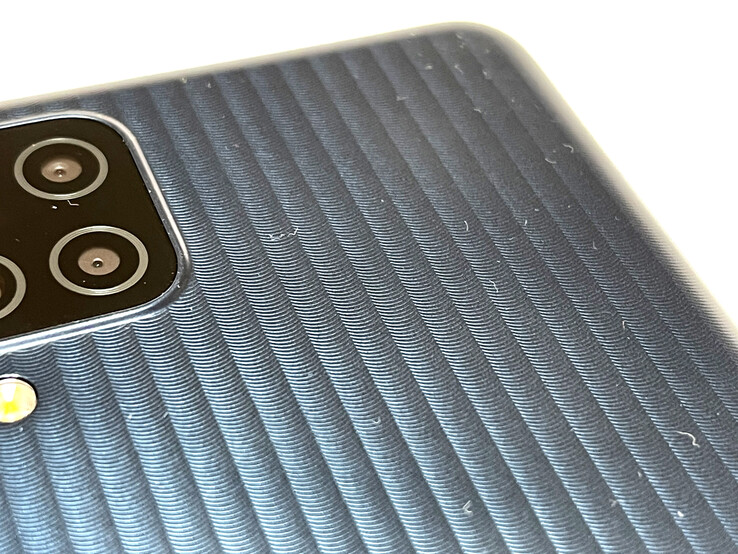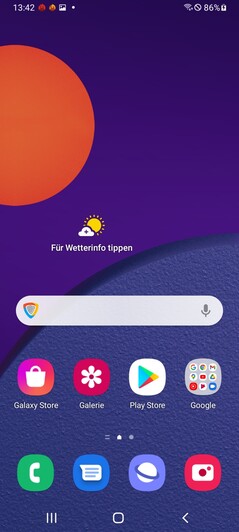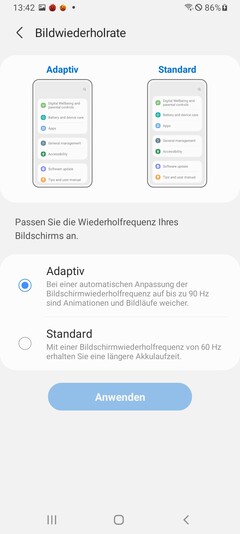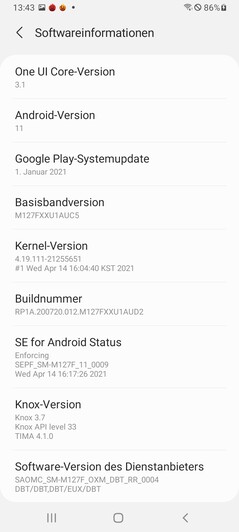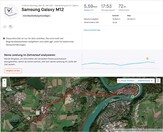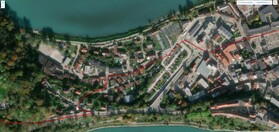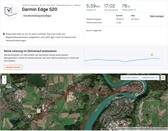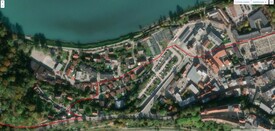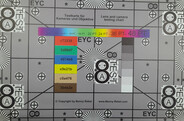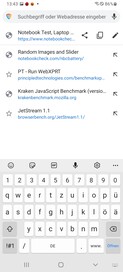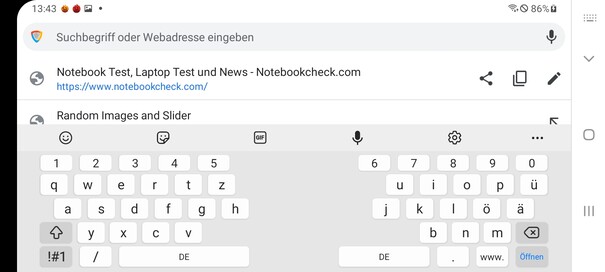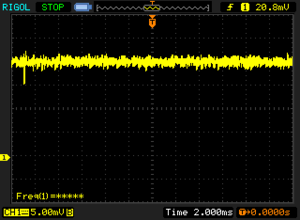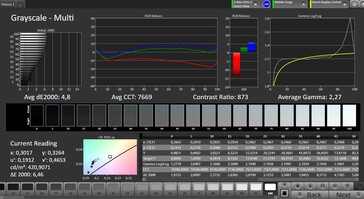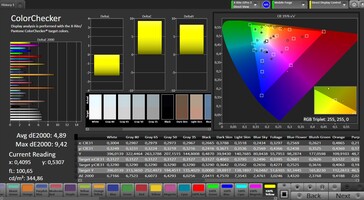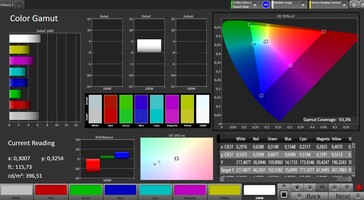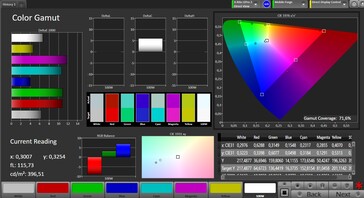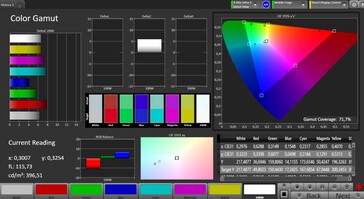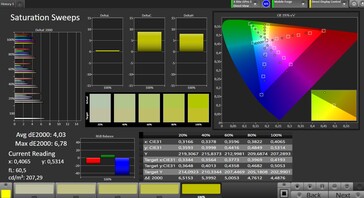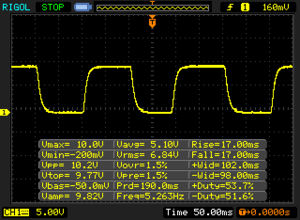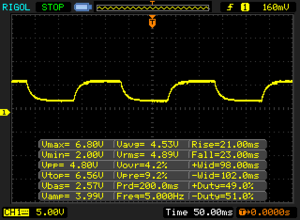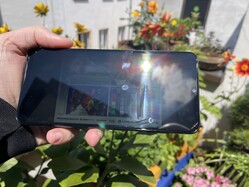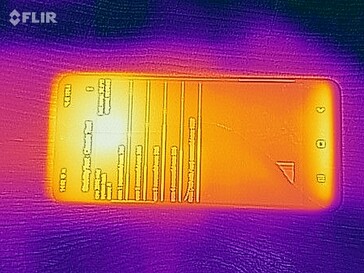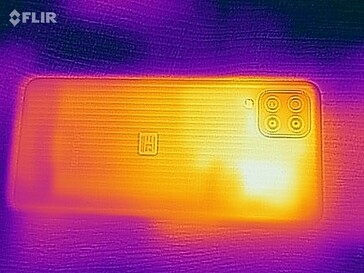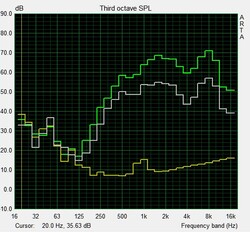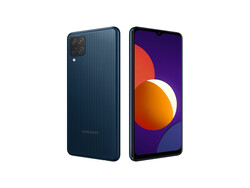Samsung Galaxy M12 smartphone review: Strong battery in the budget Galaxy phone
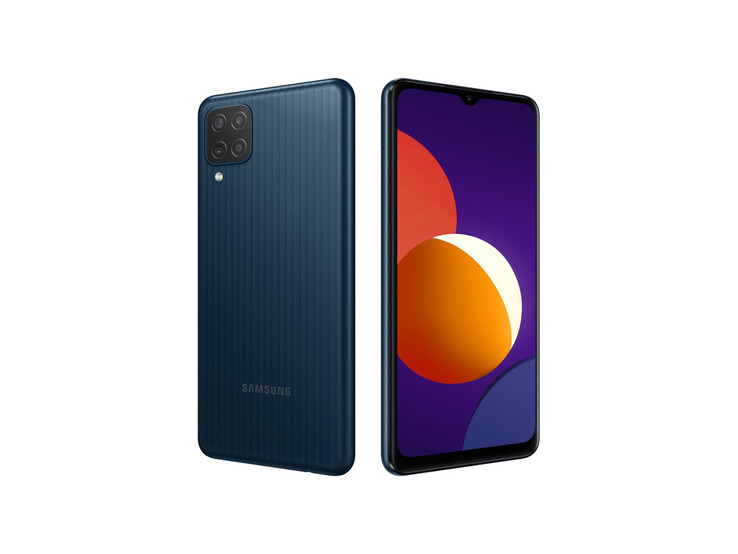
The Samsung Galaxy M12 aims to be stylish and affordable, while providing long battery life and a modern camera system with a lot of flexibility. Compared with the predecessor, the Galaxy M11, the price has increased, but the Galaxy M12 also appears to be of much higher quality and comes with more cameras.
Users who can cope with 64 GB of mass storage can get the smartphone for 179 Euros (~$217), while those who would rather have 128 GB will have to pay 199 Euros (~$241). In this review, we'll take a look at what the Galaxy offers in return and how it performs in comparison to the competition in this price range.
Possible contenders in comparison
Rating | Date | Model | Weight | Drive | Size | Resolution | Best Price |
|---|---|---|---|---|---|---|---|
| 75.7 % | 06/2021 | Samsung Galaxy M12 Exynos 850, Mali-G52 MP1 | 214 g | 64 GB eMMC Flash | 6.50" | 1600x720 | |
| 77.2 % | 01/2021 | OnePlus Nord N100 SD 460, Adreno 610 | 188 g | 64 GB UFS 2.1 Flash | 6.52" | 1600x720 | |
| 80.5 % | 05/2021 | Xiaomi Redmi Note 10 SD 678, Adreno 612 | 178.8 g | 128 GB UFS 2.2 Flash | 6.43" | 2400x1080 | |
| 77.6 % | 04/2021 | Motorola Moto G30 SD 662, Adreno 610 | 197 g | 128 GB eMMC Flash | 6.50" | 1600x720 | |
| 74.4 % | 12/2020 | Samsung Galaxy M11 SD 450, Adreno 506 | 197 g | 32 GB eMMC Flash | 6.40" | 1560x720 |
Case – Sturdy but heavy Samsung phone
The back of the Samsung Galaxy M12 shimmers in one of three different colors, depending on the customer's choice. And even though the colors are simply named "Black", "Blue" and "Green", they're actually all blue, just darker or lighter. The design on the back is divided by vertical stripes, which in turn have small semicircles carved into them, so that the back is a little reminiscent of Roman blinds or an Art Deco pattern. This looks very sleek, and the smartphone also offers a sturdy and high-quality build.
At 214 grams (~7.5 oz), however, the Galaxy M12 has become quite heavy, and at 9.7 millimeters (~0.38 in), its silhouette isn't quite as slim as that of other phones in the price range. This is somewhat surprising, since the battery offers the same capacity as in all comparison devices.
Connectivity – Only the most necessary sensors
There are two different storage configurations for the Samsung Galaxy M12: 64 GB or 128 GB of mass storage. However, it's only of the slow eMMC flash type. In addition, both models come with 4 GB of RAM.
The budget smartphone has a 3.5 mm audio jack, and the sensors only include the ones for measuring the most necessary parameters: Brightness, acceleration, and proximity.
microSD card reader
The microSD reader doesn't have to share a slot with a SIM, which means that you can make use of storage expansion and insert two SIM cards into the smartphone at the same time. The reader shows fast sequential read and write speeds with our Angelbird V60 reference card, but it's a bit slower than the Redmi Note 10.
| Cross Platform Disk Test (CPDT) | |
| SDCard Sequential Write 0.5 GB | |
| Xiaomi Redmi Note 10 | |
| Samsung Galaxy M12 | |
| SDCard Sequential Read 0.5 GB | |
| Xiaomi Redmi Note 10 | |
| Samsung Galaxy M12 | |
Cross Platform Disk Test (CPDT)
Software – Outdated security
The Galaxy M12 ships with Android 11. At the time of testing, the security patches were outdated and at the level of March 2021. The manufacturer has implemented its own OneUI 3.1 interface on top of the operating system.
Third-party apps are also preinstalled, but most of them can be uninstalled easily. There are also some Samsung apps on the smartphone that might not be needed by everyone, and not all of them can be completely removed.
Thanks to the DRM L1 certification, streaming content can also be played in HD quality.
Communication and GNSS – Slow Wi-Fi
The Galaxy M12 is equipped with NFC, so that mobile payment services can also be used. The smartphone supports some LTE frequencies in addition to the minimum, so you might still be able to access mobile Internet when traveling to slightly farther destinations; the Galaxy M12 is not a world phone, though.
In terms of Wi-Fi, only Wi-Fi 4 is on board, so you shouldn't expect excessively high speeds here. We tested this with the Netgear Nighthawk AX12 reference router. The Galaxy M12 is actually only slightly faster than its predecessor and consequently much slower than other smartphones in this price range: The differences amount to 80% and more.
The speed in everyday use also shows that the device doesn't have fast Wi-Fi 5 or 6: Websites take a long time to load, and you often have to wait for images and text to appear when scrolling. However, Internet reception is quite stable, and even at a certain distance from the router and through three walls, the speed and the signal indicator remain unchanged.
GPS, A-GPS, GLONASS, Galileo, and BeiDou are supported in terms of satellite networks. Outdoors, it takes a few seconds to detect enough satellites to determine our location. The accuracy is quite good at up to 4 meters (~13 feet).
For our real-world test, we get on our bike and take the smartphone with us as well as the Garmin Edge 520 as a reference. The distance measured is consistent, but the route tracking isn't completely accurate on our test device. Turns are repeatedly omitted, resulting in the route even passing through buildings at times. The side of the road that is being driven on isn't always determined entirely correctly, either.
However, users who don't depend on absolute accuracy during navigation will get a positioning accuracy that should be sufficient for everyday use.
Telephone and call quality – Good earpiece, moderate microphone
VoLTE and VoWiFi are supported, so you can make calls both via the 4G network as well as your home Wi-Fi, which significantly increases call quality, at least as far as networks are concerned.
We tested the smartphone's call quality with various calls. In the process, we noticed that the internal earpiece delivers quite a good quality. The person on the other end sounds loud enough, their voice doesn't blare, and it's transmitted with a lot of clarity. On the other hand, the microphone is rather mediocre, and our voice sounds a bit muffled on the other end of the line.
In hands-free mode, the speaker sounds thin. Moreover, the microphone requires a certain volume in this mode; otherwise, our voice doesn't reach the other user.
Cameras – Samsung phone with four cameras
The main camera has a resolution of 48 megapixels, but it only takes 12-megapixel pictures by default and combines every four pixels into one in order to achieve better light intensity. There's a total of four camera lenses at the back, and you can actually take pictures with three of them: Besides the main camera, these are a wide-angle camera with 5 megapixels, and a macro lens with 2 megapixels.
If you look at pictures taken with the main camera in daylight, you will notice that sharpness is rather moderate in detail. White areas are also quickly overexposed, while larger areas quickly become blotchy. Overall, the picture quality is on par with its class, but it doesn't manage to stand out positively.
Under the low light and high contrast caused by the candle flame in the picture, the lens shows a passable dynamic range, and you can also zoom into the images a bit and still see details. However, sharpness is average at best here as well.
You shouldn't enlarge photos taken with the wide-angle camera too much, since details look very fuzzy. Nonetheless, the lens is okay for snapshots.
Videos can only be recorded at Full HD and 30 fps with the main camera. This isn't unusual in this class, but the Xiaomi Redmi Note 10 shows that 4K videos are also possible at this price point. Before filming, you have to choose either the wide-angle lens or the main lens, since it's not possible to switch between them when you're recording.
The brightness adjustment in videos is a bit sluggish, but the bigger problem is the slow autofocus that only responds after a second or two and then slowly goes through all the focus levels until the right one is found. Furthermore, the Samsung Galaxy M12 can only be recommended to video fans to a very limited extent due to the its weak dynamic range.
The front-facing camera has a resolution of 8 megapixels. It allows for decent selfies as long as the photos aren't enlarged too much, since image quality quickly deteriorates in detail.
Image Comparison
Choose a scene and navigate within the first image. One click changes the position on touchscreens. One click on the zoomed-in image opens the original in a new window. The first image shows the scaled photograph of the test device.
Main camera flowerMain camera surroundingsMain camera low lightWide-angle cameraThe camera's sharpness also leaves a rather poor impression under laboratory conditions: You can see a noticeable drop in sharpness towards the edges, and the photo looks blurry even in the center. At least the bright parts of the image are still visible at 1 lux. Overall, color reproduction looks considerably too dark.
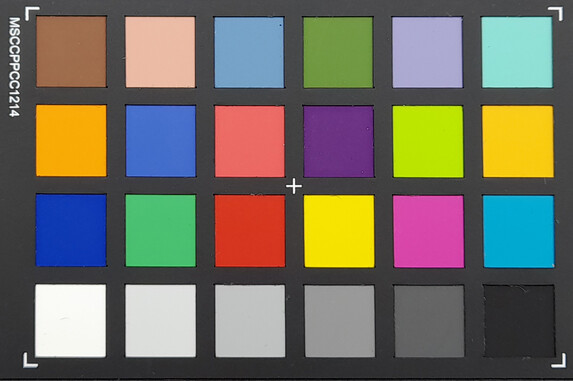
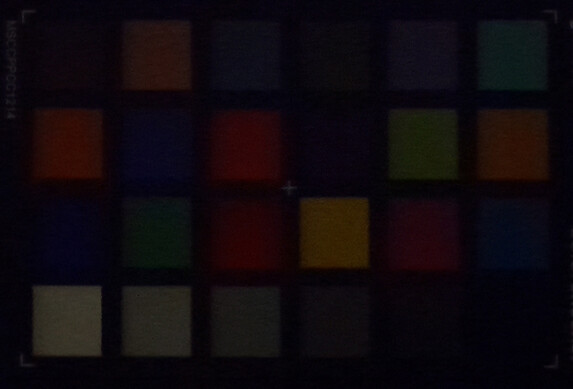
Accessories and warranty – Lots of repair options
In addition to the phone, a charger, a USB cable, and a SIM pin are included in the box. At the time of our review, there aren't any special accessories for the smartphone on Samsung's website (yet).
Samsung offers a 24-month warranty on its devices. There are repair centers in larger cities where the device can be brought over. Samsung also has an Express Repair Bus on the road in Germany, where you might even be able to have your device repaired right away. Another nice feature is that you can see the fixed price for a repair on the website. At the time of testing, however, this didn't work yet for the fairly new Galaxy M12.
Input devices and handling – 90 Hz display for smooth scrolling
The touchscreen is accurate and can be operated well overall. Thanks to the 90 Hz refresh rate, using the device feels even smoother, and scrolling works well, too. One thing we noticed was that there were small glitches when using the smartphone, where we had to press the screen very hard to activate a button. Although this happened rarely during our test, it did happen several times.
The fingerprint reader is located on the right side of the case in the standby button. It's well placed and can be operated with the thumb if you're right-handed and with the middle or index finger if you're left-handed. It unlocks the device reliably after a fairly brief pause. Software-based face recognition is also possible, and our face was recognized reliably in good lighting conditions.
Display – IPS with moderate brightness
By now, 90 Hz displays have already become very widespread in this price range, and Samsung has also equipped the Galaxy M12 with a high refresh-rate display. This makes scrolling through websites and documents in particular more fluid, and using the device also feels faster. In terms of resolution, the Galaxy phone is no trailblazer with its expanded 720p display, but it's still on par with its class.
Since it's an IPS screen, the backlight doesn't allow the display to be completely black. At 0.46 cd/m², the black level is quite high, while the contrast value is only average. This means that colors don't look that vivid on the display.
The display brightness of 426 cd/m² is on par with the predecessor and at a medium level compared with the smartphone's class.
| |||||||||||||||||||||||||
Brightness Distribution: 89 %
Center on Battery: 426 cd/m²
Contrast: 926:1 (Black: 0.46 cd/m²)
ΔE Color 4.89 | 0.5-29.43 Ø5
ΔE Greyscale 4.8 | 0.57-98 Ø5.3
93.3% sRGB (Calman 2D)
Gamma: 2.27
| Samsung Galaxy M12 IPS, 1600x720, 6.50 | OnePlus Nord N100 IPS, 1600x720, 6.52 | Xiaomi Redmi Note 10 AMOLED, 2400x1080, 6.43 | Motorola Moto G30 LCD IPS, 1600x720, 6.50 | Samsung Galaxy M11 PLS TFT LCD, 1560x720, 6.40 | |
|---|---|---|---|---|---|
| Screen | 30% | 50% | 6% | -2% | |
| Brightness middle | 426 | 474 11% | 695 63% | 284 -33% | 430 1% |
| Brightness | 428 | 456 7% | 693 62% | 263 -39% | 406 -5% |
| Brightness Distribution | 89 | 86 -3% | 98 10% | 83 -7% | 91 2% |
| Black Level * | 0.46 | 0.35 24% | 0.34 26% | 0.52 -13% | |
| Contrast | 926 | 1354 46% | 835 -10% | 827 -11% | |
| Colorchecker dE 2000 * | 4.89 | 2.7 45% | 2.2 55% | 2.92 40% | 4.55 7% |
| Colorchecker dE 2000 max. * | 9.42 | 4.89 48% | 4.8 49% | 5.06 46% | 7.93 16% |
| Greyscale dE 2000 * | 4.8 | 1.9 60% | 1.9 60% | 3.6 25% | 5.4 -13% |
| Gamma | 2.27 97% | 2.31 95% | 2.25 98% | 2.307 95% | 2.103 105% |
| CCT | 7669 85% | 6430 101% | 6286 103% | 6780 96% | 7793 83% |
* ... smaller is better
Screen Flickering / PWM (Pulse-Width Modulation)
| Screen flickering / PWM not detected | |||
In comparison: 53 % of all tested devices do not use PWM to dim the display. If PWM was detected, an average of 17933 (minimum: 5 - maximum: 3846000) Hz was measured. | |||
We didn't detect any PWM flickering. Color reproduction is averagely accurate, but it's probably not sufficient for demanding users: Grayscales show a slight blue tint, while yellow and orange tones in particular are reproduced incorrectly by the display.
Display Response Times
| ↔ Response Time Black to White | ||
|---|---|---|
| 34 ms ... rise ↗ and fall ↘ combined | ↗ 17 ms rise | |
| ↘ 17 ms fall | ||
| The screen shows slow response rates in our tests and will be unsatisfactory for gamers. In comparison, all tested devices range from 0.1 (minimum) to 240 (maximum) ms. » 89 % of all devices are better. This means that the measured response time is worse than the average of all tested devices (21.5 ms). | ||
| ↔ Response Time 50% Grey to 80% Grey | ||
| 44 ms ... rise ↗ and fall ↘ combined | ↗ 21 ms rise | |
| ↘ 23 ms fall | ||
| The screen shows slow response rates in our tests and will be unsatisfactory for gamers. In comparison, all tested devices range from 0.2 (minimum) to 636 (maximum) ms. » 69 % of all devices are better. This means that the measured response time is worse than the average of all tested devices (33.8 ms). | ||
The maximum brightness is still sufficient to be able to make out screen contents in bright surroundings, but brighter displays have a clear advantage here. As is typical for IPS displays, viewing angles are good. At most, a slight color shift is visible when looking at the screen from very flat angles.
Performance – Passable power
The Samsung Exynos 850 is used as the SoC. It offers 8 cores with a performance of up to 2 GHz, and it's a popular centerpiece in Samsung's cheapest smartphones. Therefore, the Galaxy M12 can't stand out in terms of processor performance, and graphics performance is only mediocre as well. However, there's a significant performance increase compared with the predecessor, the Galaxy M11.
In everyday use, you have to put up with stutters when running complex apps, especially when you want to adjust the volume or run other tasks in parallel. Overall, however, the system runs quite smoothly and feels pretty responsive thanks to the 90 Hz display.
| AnTuTu v8 - Total Score (sort by value) | |
| Samsung Galaxy M12 | |
| OnePlus Nord N100 | |
| Xiaomi Redmi Note 10 | |
| Motorola Moto G30 | |
| Samsung Galaxy M11 | |
| Average Samsung Exynos 850 (119981 - 133391, n=4) | |
Internet browsing is usually slower on Samsung's Galaxy M12 than on other devices in the price range. Although there's an advantage over the predecessor here as well, it's still only sufficient for a place in the bottom range of the comparison devices.
In everyday use, this means that you often have to wait for pictures to load when scrolling and that pages load slower.
| Jetstream 2 - Total Score | |
| Average of class Smartphone (13.8 - 351, n=172, last 2 years) | |
| Xiaomi Redmi Note 10 (Chrome 90) | |
| Motorola Moto G30 (Chrome89) | |
| OnePlus Nord N100 (Chrome 87) | |
| Average Samsung Exynos 850 (18.4 - 23, n=6) | |
| Samsung Galaxy M12 (Chrome 90) | |
| Samsung Galaxy M11 (Chrome 87) | |
| JetStream 1.1 - Total Score | |
| Average of class Smartphone (last 2 years) | |
| Xiaomi Redmi Note 10 (Chrome 90) | |
| Motorola Moto G30 (Chrome89) | |
| OnePlus Nord N100 (Chrome 87) | |
| Average Samsung Exynos 850 (27.1 - 32.5, n=4) | |
| Samsung Galaxy M12 (Chrome 90) | |
| Samsung Galaxy M11 (Chrome 87) | |
| Speedometer 2.0 - Result | |
| Average of class Smartphone (14.9 - 445, n=157, last 2 years) | |
| Xiaomi Redmi Note 10 (Chrome 90) | |
| Motorola Moto G30 (Chrome89) | |
| OnePlus Nord N100 (Chome 87) | |
| Average Samsung Exynos 850 (15 - 16.7, n=6) | |
| Samsung Galaxy M12 (Chome 90) | |
| Samsung Galaxy M11 (Chrome 87) | |
| WebXPRT 3 - Overall | |
| Average of class Smartphone (39 - 304, n=122, last 2 years) | |
| Xiaomi Redmi Note 10 (Chrome 90) | |
| Motorola Moto G30 (Chrome89) | |
| OnePlus Nord N100 (Chrome 87) | |
| Average Samsung Exynos 850 (35 - 39, n=6) | |
| Samsung Galaxy M12 (Chrome 90) | |
| Samsung Galaxy M11 (Chrome 87) | |
| Octane V2 - Total Score | |
| Average of class Smartphone (4633 - 89112, n=210, last 2 years) | |
| Xiaomi Redmi Note 10 (Chrome 90) | |
| Motorola Moto G30 (Chrome89) | |
| OnePlus Nord N100 (Chrome 87) | |
| Average Samsung Exynos 850 (4875 - 5904, n=6) | |
| Samsung Galaxy M12 (Chrome 90) | |
| Samsung Galaxy M11 (Chrome 87) | |
| Mozilla Kraken 1.1 - Total | |
| Samsung Galaxy M11 (Chrome 87) | |
| Samsung Galaxy M12 (Chrome 90) | |
| Average Samsung Exynos 850 (8327 - 9397, n=6) | |
| OnePlus Nord N100 (Chrome 87) | |
| Motorola Moto G30 (Chrome89) | |
| Xiaomi Redmi Note 10 (Chrome 90) | |
| Average of class Smartphone (388 - 9999, n=172, last 2 years) | |
* ... smaller is better
Slow eMMC flash storage is no longer considered an achievement in this price range. Devices from OnePlus or Xiaomi now offer much faster storage. The Galaxy M12 is at least faster than its predecessor, but copying data takes a long time, and you also notice a difference when starting apps compared to devices with faster storage.
| Samsung Galaxy M12 | OnePlus Nord N100 | Xiaomi Redmi Note 10 | Motorola Moto G30 | Samsung Galaxy M11 | Average 64 GB eMMC Flash | Average of class Smartphone | |
|---|---|---|---|---|---|---|---|
| AndroBench 3-5 | 30% | 37% | -8% | -24% | -36% | 284% | |
| Sequential Read 256KB | 311.4 | 504 62% | 497.4 60% | 214.5 -31% | 297.6 -4% | 273 ? -12% | 1505 ? 383% |
| Sequential Write 256KB | 249.3 | 219 -12% | 241.5 -3% | 190.2 -24% | 81.4 -67% | 176.8 ? -29% | 1112 ? 346% |
| Random Read 4KB | 120.9 | 106.1 -12% | 131.5 9% | 247.4 105% | 73.9 -39% | 59.1 ? -51% | 247 ? 104% |
| Random Write 4KB | 67.2 | 120.8 80% | 122.1 82% | 12.2 -82% | 78.1 16% | 31.7 ? -53% | 271 ? 303% |
Games – No gaming at 90 fps
Just because the smartphone has a 90 Hz display, it doesn't mean that you can automatically play every game at 90 fps. For starters, the game has to be capable of this; moreover, the smartphone manufacturer has to allow it; and finally, the phone has to be powerful enough to render the 90 fps.
Unfortunately, the Samsung Galaxy M12 isn't a perfect example here: Even in simpler games like Armajet, which actually support high frame rates, you can't get more than 40 fps. Naturally, the overall gaming performance isn't particularly high in this price range, but it's usually sufficient for simpler games or reduced details in more complex games if you tolerate occasional stutters.
By the way, we use our partner GameBench's software to measure the fps.
Emissions – Significant throttling
Temperature
According to our measurements, the maximum temperature of the case is 39.5 °C (~103 °F). This is noticeable but not critical; heat development could only become a bit unpleasant in very hot ambient temperatures.
We also take a look at whether and how much the system throttles when it's under prolonged load. If the cooling system doesn't do a good job of diverting the generated heat away from the SoC, the processor might have to reduce its performance to avoid overheating.
This is the case with the Galaxy M12. The 3DMark Wild Life stress test shows a consistent performance for quite a long time, but it drops very sharply towards the end of the benchmark. In the end, only about 60% of the initial performance remains. At the same time, the GFXBench Manhattan test doesn't show any throttling. This means that the smartphone probably has to be under very heavy load to experience a performance decrease.
| 3DMark | |
| Wild Life Stress Test Stability | |
| Motorola Moto G30 | |
| Xiaomi Redmi Note 10 | |
| OnePlus Nord N100 | |
| Samsung Galaxy M12 | |
| Wild Life Extreme Stress Test | |
| Xiaomi Redmi Note 10 | |
| Samsung Galaxy M12 | |
(+) The maximum temperature on the upper side is 39.5 °C / 103 F, compared to the average of 35 °C / 95 F, ranging from 21.9 to 56 °C for the class Smartphone.
(+) The bottom heats up to a maximum of 38.3 °C / 101 F, compared to the average of 33.8 °C / 93 F
(+) In idle usage, the average temperature for the upper side is 28 °C / 82 F, compared to the device average of 32.7 °C / 91 F.
Speaker
The mono speaker of the Samsung Galaxy M12 is found at the bottom of the case. It delivers an average volume, and it lacks audible bass tones, which is common for most smartphones. There are some low mids, but the speaker generally sounds quite high-pitched.
At maximum power, these highs also sound unpleasant to the ears, but if you lower the volume by just one level, the sound starts to become rounder. The speaker isn't really that enjoyable, but it can be used for listening to music.
Needless to say, sound is better when you use the 3.5 mm audio jack or Bluetooth to connect decent headphones or speakers. Bluetooth 5.0 is a somewhat older version of the wireless interface, and you'll also have to do without aptX HD when it comes to codecs.
Samsung Galaxy M12 audio analysis
(±) | speaker loudness is average but good (77.6 dB)
Bass 100 - 315 Hz
(-) | nearly no bass - on average 27.6% lower than median
(±) | linearity of bass is average (13% delta to prev. frequency)
Mids 400 - 2000 Hz
(+) | balanced mids - only 4.9% away from median
(+) | mids are linear (6.9% delta to prev. frequency)
Highs 2 - 16 kHz
(±) | higher highs - on average 6.8% higher than median
(±) | linearity of highs is average (7.3% delta to prev. frequency)
Overall 100 - 16.000 Hz
(-) | overall sound is not linear (30.8% difference to median)
Compared to same class
» 76% of all tested devices in this class were better, 4% similar, 20% worse
» The best had a delta of 12%, average was 38%, worst was 134%
Compared to all devices tested
» 87% of all tested devices were better, 3% similar, 10% worse
» The best had a delta of 4%, average was 25%, worst was 134%
Motorola Moto G30 audio analysis
(+) | speakers can play relatively loud (82.2 dB)
Bass 100 - 315 Hz
(-) | nearly no bass - on average 66.6% lower than median
(+) | bass is linear (0% delta to prev. frequency)
Mids 400 - 2000 Hz
(-) | nearly no mids - on average 66.6% lower than median
(+) | mids are linear (0% delta to prev. frequency)
Highs 2 - 16 kHz
(-) | nearly no highs - on average 66.6% lower than median
(+) | highs are linear (0% delta to prev. frequency)
Overall 100 - 16.000 Hz
(-) | overall sound is not linear (119.4% difference to median)
Compared to same class
» 86% of all tested devices in this class were better, 10% similar, 4% worse
» The best had a delta of 12%, average was 38%, worst was 134%
Compared to all devices tested
» 96% of all tested devices were better, 3% similar, 1% worse
» The best had a delta of 4%, average was 25%, worst was 134%
Battery life – Galaxy phone with long charging times
Energy consumption
There is good news and bad news in terms of the Samsung Galaxy M12's energy consumption: On one hand, the smartphone doesn't need as much energy as some competitors under load, but on the other hand, consumption is relatively high under low load.
Therefore, those who want to use their smartphone for complex apps will get an efficient device, but users who prefer to use the device for web browsing at low screen brightness will have to be prepared for a higher consumption than with some other smartphones in the price range.
| Off / Standby | |
| Idle | |
| Load |
|
| Samsung Galaxy M12 5000 mAh | OnePlus Nord N100 5000 mAh | Xiaomi Redmi Note 10 5000 mAh | Motorola Moto G30 5000 mAh | Samsung Galaxy M11 5000 mAh | Average Samsung Exynos 850 | Average of class Smartphone | |
|---|---|---|---|---|---|---|---|
| Power Consumption | 8% | 5% | -9% | -15% | -4% | -6% | |
| Idle Minimum * | 1 | 0.56 44% | 0.74 26% | 0.8 20% | 1 -0% | 1.2 ? -20% | 0.897 ? 10% |
| Idle Average * | 1.6 | 1.8 -13% | 1.68 -5% | 1.5 6% | 1.3 19% | 1.733 ? -8% | 1.452 ? 9% |
| Idle Maximum * | 2.3 | 2.3 -0% | 1.69 27% | 1.8 22% | 1.6 30% | 2.28 ? 1% | 1.629 ? 29% |
| Load Average * | 4 | 3.9 2% | 4.64 -16% | 6.1 -53% | 7.1 -78% | 3.83 ? 4% | 5.55 ? -39% |
| Load Maximum * | 6 | 5.6 7% | 6.48 -8% | 8.4 -40% | 8.8 -47% | 5.73 ? 4% | 8.31 ? -39% |
* ... smaller is better
Battery life
Samsung installs a 5,000 mAh battery in the Galaxy smartphone under review. This puts the device on par with the price range.
Although the runtimes differ slightly upwards and downwards in some areas, the Samsung Galaxy M12's battery life is quite similar to the predecessor's on the whole. Our review sample lasted 15:26 hours in our standardized Wi-Fi test, which should be enough for two workdays without recharging the battery.
The charger has a maximum capacity of 15 watts. Depending on the battery level, it can take up to 2:30 hours to charge such a high-capacity battery with it. It also takes longer than with other smartphones that have faster charging technologies for users to have enough power for several hours of use when the battery is low. Some examples of faster charging times are the Xiaomi Redmi Note 10 or the Motorola Moto G30.
| Samsung Galaxy M12 5000 mAh | OnePlus Nord N100 5000 mAh | Xiaomi Redmi Note 10 5000 mAh | Motorola Moto G30 5000 mAh | Samsung Galaxy M11 5000 mAh | |
|---|---|---|---|---|---|
| Battery Runtime | 13% | 20% | 8% | 5% | |
| Reader / Idle | 2103 | 2513 19% | 2767 32% | 2336 11% | 2024 -4% |
| H.264 | 1059 | 1206 14% | 1424 34% | 1349 27% | 1046 -1% |
| WiFi v1.3 | 926 | 1149 24% | 889 -4% | 1069 15% | 880 -5% |
| Load | 286 | 267 -7% | 341 19% | 219 -23% | 369 29% |
Pros
Cons
Verdict – Galaxy phone with decent features and weak camera
The Samsung Galaxy M12 is an affordable mid-range phone with a large battery and a 90 Hz display. The Galaxy smartphone looks stylish and offers significantly more storage than the predecessor.
However, it also has some weaknesses that you should know about before buying, especially when you consider alternative devices that have a similar price: For example, Wi-Fi is quite slow, the camera takes quite blurry pictures at times, charging takes a rather long time, and the device is pretty heavy. We also find it annoying that the security patches are outdated.
With the Galaxy M12, Samsung brings an affordable, stylish phone with a 90 Hz display onto the market. However, it has some catching up to do in terms of camera, Wi-Fi, and software updates.
The Galaxy M12 does well in terms of performance, though, and you get NFC, which is not a given on all devices under 200 Euros (~$243). The manufacturer has also foregone the use of PWM on the display, which is a relief for sensitive users. In addition, there's a DRM L1 certification, so that video streams can be enjoyed in HD quality.
Overall, we recommend the Galaxy M12 if you don't place too much value on the camera and can handle the slow Wi-Fi.
Price and availability
At the time of writing, the Samsung Galaxy M12 is a bit hard to find if you're in the United States. Nonetheless, you can find some listings for it on ebay, with the 4/64 GB version costing around $200 and the 6/128 GB one around $265. Alternatively, you can also keep tabs on Amazon and wait for the device to pop up there.
Samsung Galaxy M12
-
05/31/2021 v7
Florian Schmitt


 Deutsch
Deutsch English
English Español
Español Français
Français Italiano
Italiano Nederlands
Nederlands Polski
Polski Português
Português Русский
Русский Türkçe
Türkçe Svenska
Svenska Chinese
Chinese Magyar
Magyar